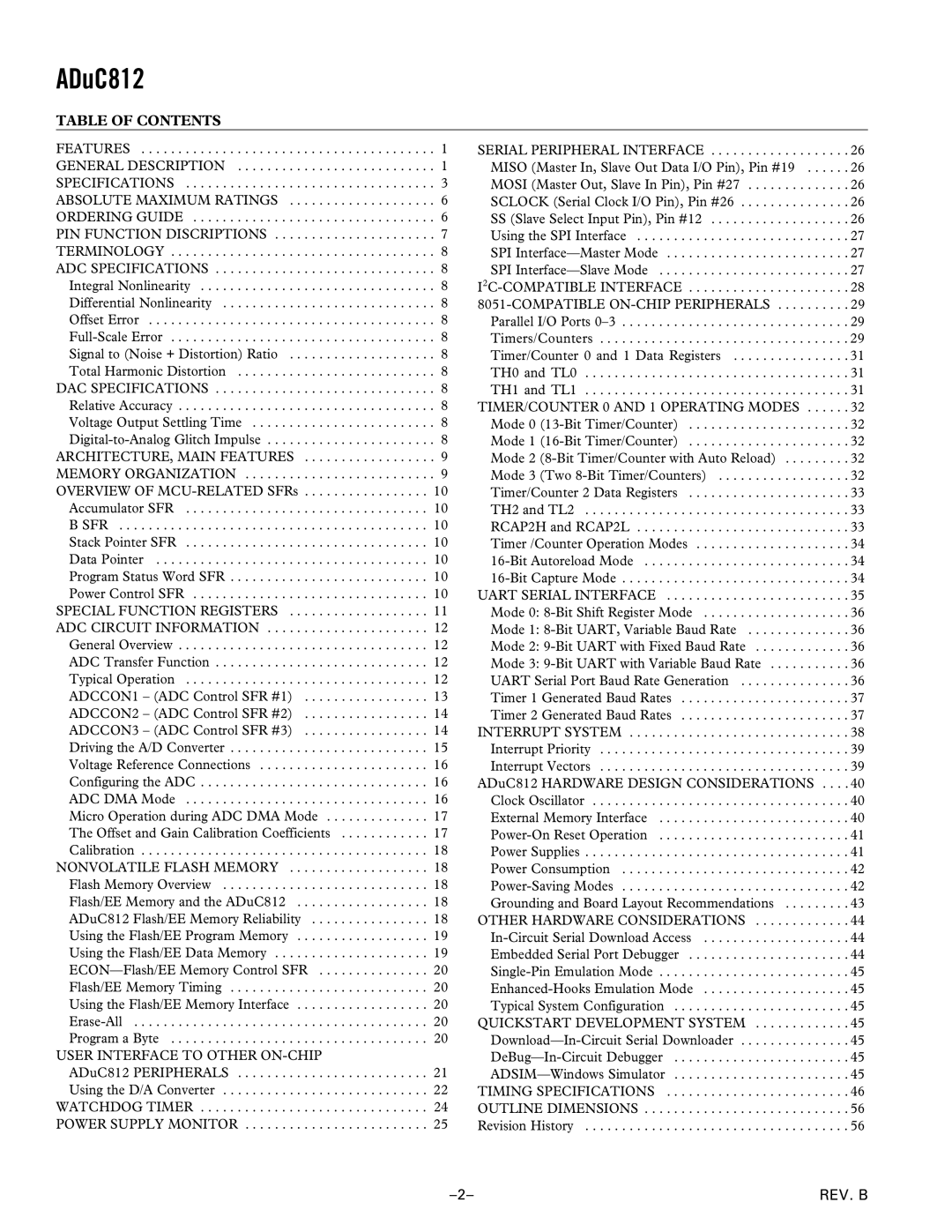ADuC812
TABLE OF CONTENTS
FEATURES | . 1 |
GENERAL DESCRIPTION | . 1 |
SPECIFICATIONS | . 3 |
ABSOLUTE MAXIMUM RATINGS | . 6 |
ORDERING GUIDE | . 6 |
PIN FUNCTION DISCRIPTIONS | . 7 |
TERMINOLOGY | . 8 |
ADC SPECIFICATIONS | . 8 |
Integral Nonlinearity | . 8 |
Differential Nonlinearity | . 8 |
Offset Error | . 8 |
. 8 | |
Signal to (Noise + Distortion) Ratio | . 8 |
Total Harmonic Distortion | . 8 |
DAC SPECIFICATIONS | . 8 |
Relative Accuracy | . 8 |
Voltage Output Settling Time | . 8 |
. 8 | |
ARCHITECTURE, MAIN FEATURES | . 9 |
MEMORY ORGANIZATION | . 9 |
OVERVIEW OF | 10 |
Accumulator SFR | 10 |
B SFR | 10 |
Stack Pointer SFR | 10 |
Data Pointer | 10 |
Program Status Word SFR | 10 |
Power Control SFR | 10 |
SPECIAL FUNCTION REGISTERS | 11 |
ADC CIRCUIT INFORMATION | 12 |
General Overview | 12 |
ADC Transfer Function | 12 |
Typical Operation | 12 |
ADCCON1 – (ADC Control SFR #1) | 13 |
ADCCON2 – (ADC Control SFR #2) | 14 |
ADCCON3 – (ADC Control SFR #3) | 14 |
Driving the A/D Converter | 15 |
Voltage Reference Connections | 16 |
Configuring the ADC | 16 |
ADC DMA Mode | 16 |
Micro Operation during ADC DMA Mode | 17 |
The Offset and Gain Calibration Coefficients | 17 |
Calibration | 18 |
NONVOLATILE FLASH MEMORY | 18 |
Flash Memory Overview | 18 |
Flash/EE Memory and the ADuC812 | 18 |
ADuC812 Flash/EE Memory Reliability | 18 |
Using the Flash/EE Program Memory | 19 |
Using the Flash/EE Data Memory | 19 |
20 | |
Flash/EE Memory Timing | 20 |
Using the Flash/EE Memory Interface | 20 |
20 | |
Program a Byte | 20 |
USER INTERFACE TO OTHER |
|
ADuC812 PERIPHERALS | 21 |
Using the D/A Converter | 22 |
WATCHDOG TIMER | 24 |
POWER SUPPLY MONITOR | 25 |
SERIAL PERIPHERAL INTERFACE | 26 |
MISO (Master In, Slave Out Data I/O Pin), Pin #19 | 26 |
MOSI (Master Out, Slave In Pin), Pin #27 | 26 |
SCLOCK (Serial Clock I/O Pin), Pin #26 | 26 |
SS (Slave Select Input Pin), Pin #12 | 26 |
Using the SPI Interface | 27 |
SPI | 27 |
SPI | 27 |
28 | |
29 | |
Parallel I/O Ports | 29 |
Timers/Counters | 29 |
Timer/Counter 0 and 1 Data Registers | 31 |
TH0 and TL0 | 31 |
TH1 and TL1 | 31 |
TIMER/COUNTER 0 AND 1 OPERATING MODES | 32 |
Mode 0 | 32 |
Mode 1 | 32 |
Mode 2 | 32 |
Mode 3 (Two | 32 |
Timer/Counter 2 Data Registers | 33 |
TH2 and TL2 | 33 |
RCAP2H and RCAP2L | 33 |
Timer /Counter Operation Modes | 34 |
34 | |
34 | |
UART SERIAL INTERFACE | 35 |
Mode 0: | 36 |
Mode 1: | 36 |
Mode 2: | 36 |
Mode 3: | 36 |
UART Serial Port Baud Rate Generation | 36 |
Timer 1 Generated Baud Rates | 37 |
Timer 2 Generated Baud Rates | 37 |
INTERRUPT SYSTEM | 38 |
Interrupt Priority | 39 |
Interrupt Vectors | 39 |
ADuC812 HARDWARE DESIGN CONSIDERATIONS . . . . 40 | |
Clock Oscillator | 40 |
External Memory Interface | 40 |
41 | |
Power Supplies | 41 |
Power Consumption | 42 |
42 | |
Grounding and Board Layout Recommendations | 43 |
OTHER HARDWARE CONSIDERATIONS | 44 |
44 | |
Embedded Serial Port Debugger | 44 |
45 | |
45 | |
Typical System Configuration | 45 |
QUICKSTART DEVELOPMENT SYSTEM | 45 |
45 | |
45 | |
45 | |
TIMING SPECIFICATIONS | 46 |
OUTLINE DIMENSIONS | 56 |
Revision History | 56 |
REV. B |
